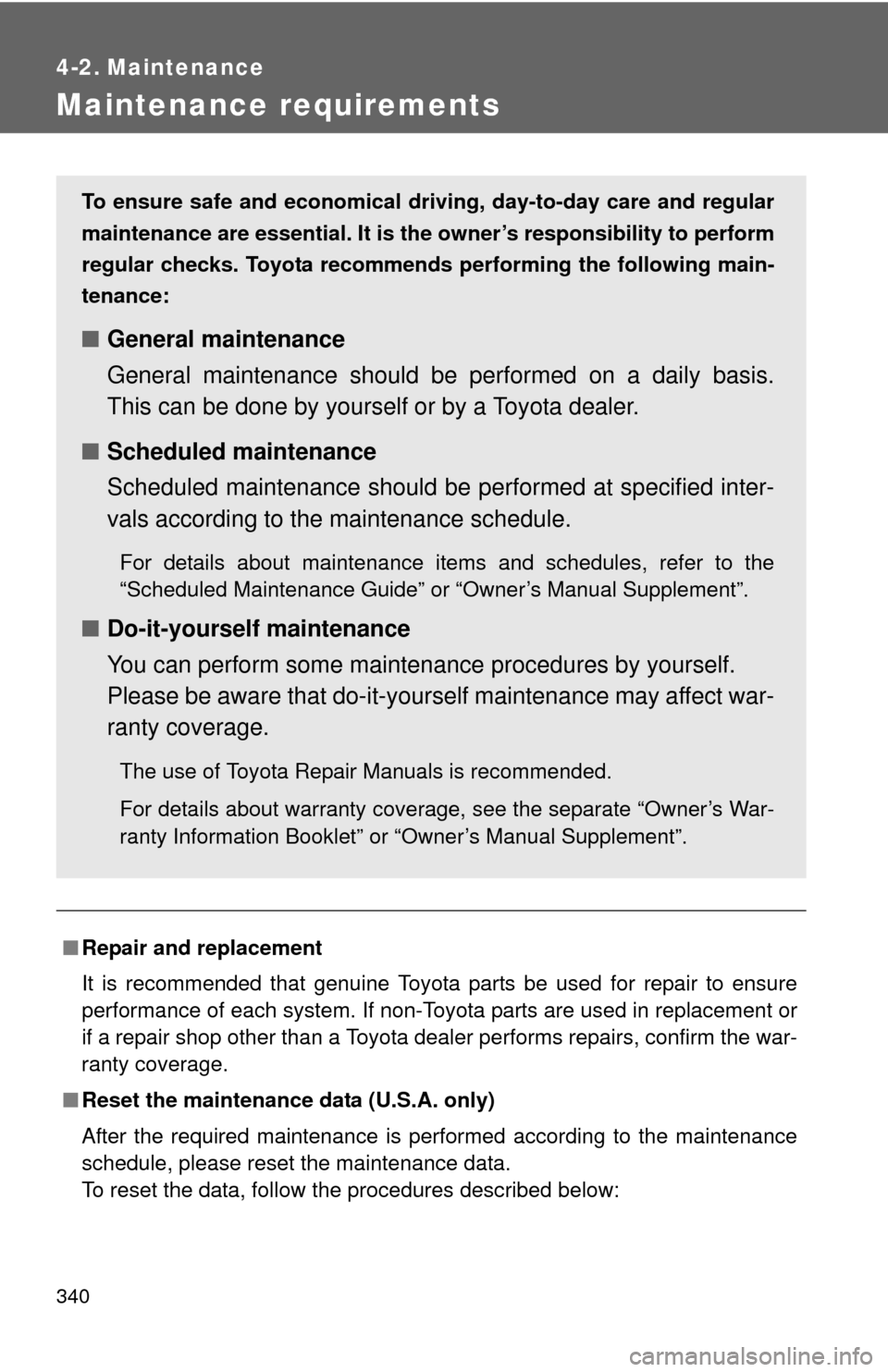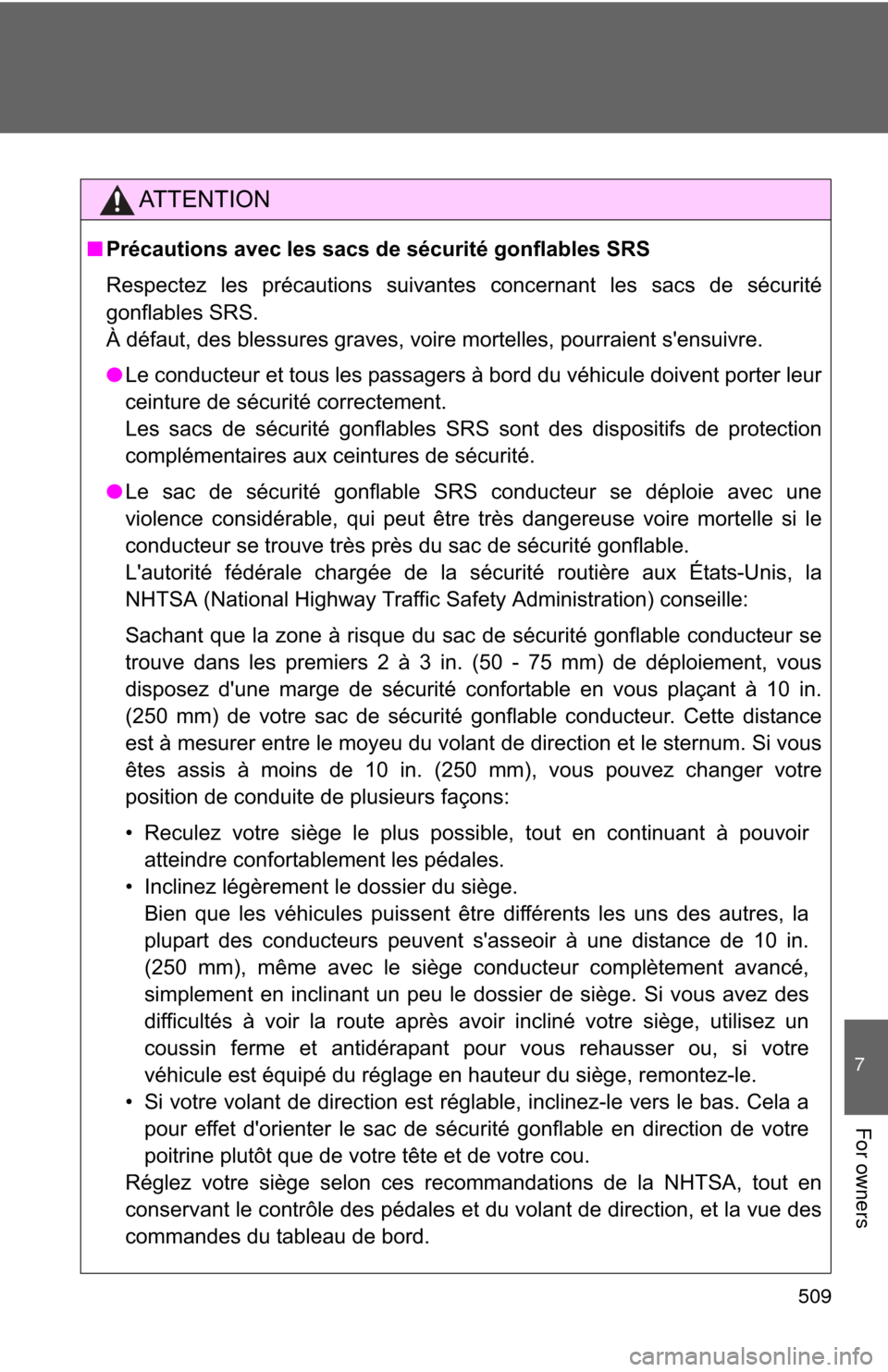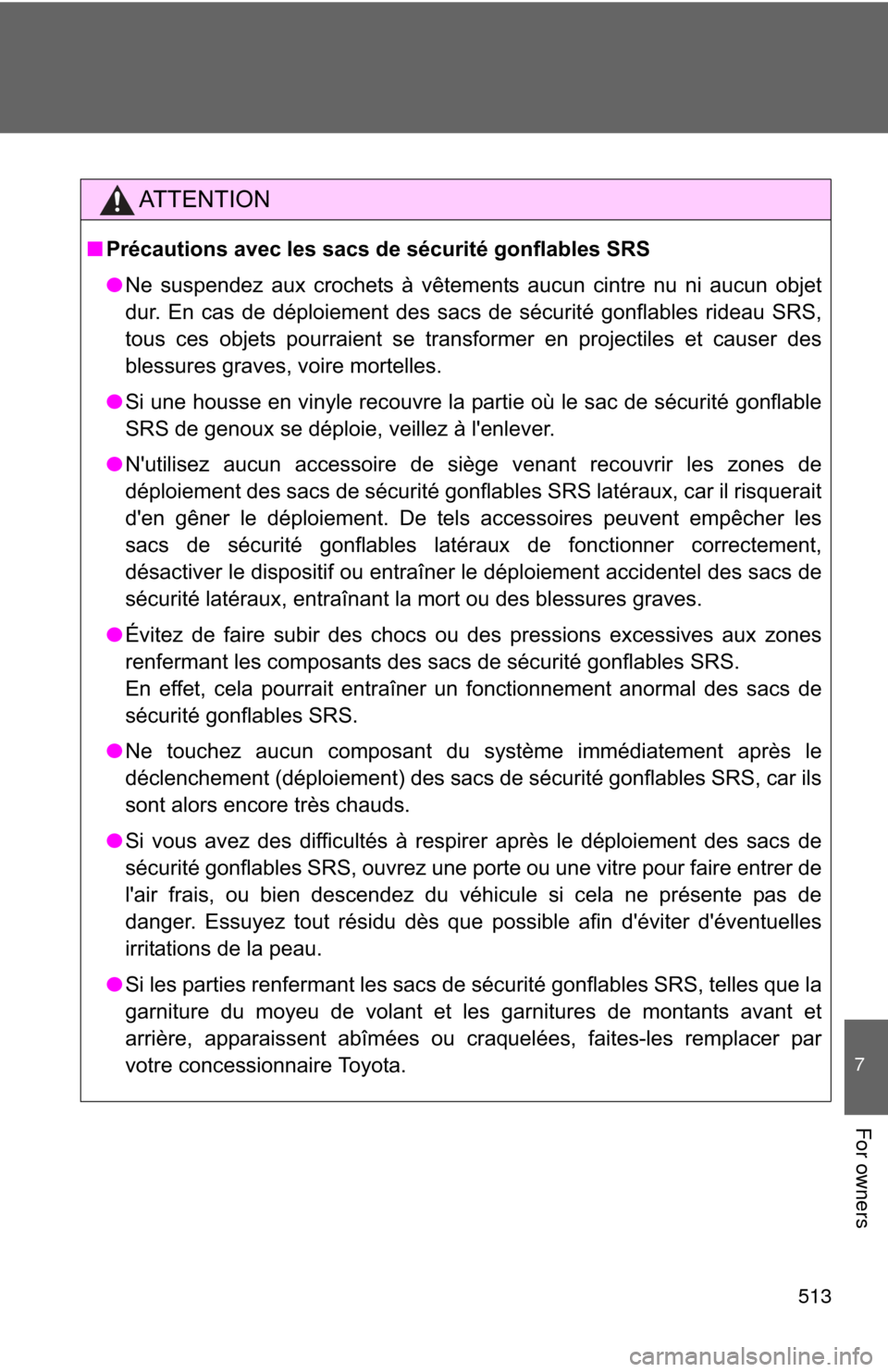2012 TOYOTA CAMRY ESP
[x] Cancel search: ESPPage 339 of 532

339
4-1. Maintenance and care
4
Maintenance and care
NOTICE
■
Cleaning detergents
●Do not use the following types of detergent, as they may discolor the vehi-
cle interior or cause streaks or damage to painted surfaces:
• Non-seat portions: Organic substances such as benzene or gasoline,
alkaline or acidic solutions, dye, and bleach
• Seats: Alkaline or acidic solutions, such as thinner, benzene, and alco- hol
● Do not use polish wax or polish cleaner. The instrument panel's or other
interior part’s painted surface may be damaged.
■ Preventing damage to leather surfaces
Observe the following precautions to avoid damage to and deterioration o\
f
leather surfaces:
●Remove any dust or dirt from leather surfaces immediately.
● Do not expose the vehicle to direct sunlight for extended periods of time.
Park the vehicle in the shade, especially during summer.
● Do not place items made of vinyl, plastic, or containing wax on the uphol-
stery, as they may stick to the leather surface if the vehicle interior heats
up significantly.
■ Water on the floor
Do not wash the vehicle floor with water.
Vehicle systems such as the audio system may be damaged if water comes
into contact with electrical components such as the audio system above or
under the floor of the vehicle. Water may also cause the body to rust.
■ Cleaning the inside of the rear window
●Do not use glass cleaner to clean the rear window, as this may cause
damage to the rear window defogger heater wires or antenna. Use a cloth
dampened with lukewarm water to gently wipe the window clean. Wipe the
window in strokes running parallel to the heater wires or antenna.
● Be careful not to scratch or damage the heater wires or antenna.
Page 340 of 532

340
4-2. Maintenance
Maintenance requirements
■Repair and replacement
It is recommended that genuine Toyota parts be used for repair to ensure
performance of each system. If non-Toyota parts are used in replacement or
if a repair shop other than a Toyota dealer performs repairs, confirm the war-
ranty coverage.
■ Reset the maintenance data (U.S.A. only)
After the required maintenance is performed according to the maintenance
schedule, please reset the maintenance data.
To reset the data, follow the procedures described below:
To ensure safe and economical driv ing, day-to-day care and regular
maintenance are essential. It is the owner’s responsibility to perform
regular checks. Toyota recommends performing the following main-
tenance:
■ General maintenance
General maintenance should be performed on a daily basis.
This can be done by yourself or by a Toyota dealer.
■ Scheduled maintenance
Scheduled maintenance should be performed at specified inter-
vals according to the maintenance schedule.
For details about maintenance items and schedules, refer to the
“Scheduled Maintenance Guide” or “Owner’s Manual Supplement”.
■Do-it-yourself maintenance
You can perform some maintenance procedures by yourself.
Please be aware that do-it-yourself maintenance may affect war-
ranty coverage.
The use of Toyota Repair Manuals is recommended.
For details about warranty coverage, see the separate “Owner’s War-
ranty Information Booklet” or “Owner’s Manual Supplement”.
Page 372 of 532

372 4-3. Do-it-yourself maintenance
■Initializing the tire pressure warning system
Initialize the system with the tire infl ation pressure adjusted to the speci-
fied level.
■If the tread on snow tires wears down below 0.16 in. (4 mm)
The effectiveness of the tires as snow tires is lost.
■If you press the tire pressure warning reset switch accidentally
If initialization is performed, adjust the tire in flation pressure to the speci-
fied level and initialize the tire pressure warning system again.
■When the initialization of the tire pressure warning system has
failed
Initialization can be completed in a few minutes. However, in the follow-
ing cases, the settings have not b een recorded and the system will not
operate properly. If repeated attempts to record tire inflation pressure
settings are unsuccessful, have the vehicle inspected by your Toyota
dealer.
●When operating the tire pressure warning reset switch, the tire pres-
sure warning light does not blink 3 times.
●After driving for a certain period of time since the initialization has
been completed, the warning light comes on after blinking for 1
minute.
■Certification for the tire pressure warning system
FCC ID: PAXPMVC010
FCC ID: HYQ23AAD
NOTE:
This device complies with Part 15 of the FCC Rules. Operation is subject
to the following two conditions: (1) This device may not cause harmful
interference, and (2) this device must accept any interference received,
including interference that may cause undesired operation.
FCC WARNING:
Changes or modifications not expre ssly approved by the party responsi-
ble for compliance could void the user's authority to operate the equip-
ment.
Page 433 of 532

5
When trouble arises
433
5-2. Steps to take in an emergency
CAUTION
■If a blowout or sudden air leakage
should occur (vehicles with a tire
pressure warning system)
The tire pressure warning syste m may not activate immediately.
■Maintenance of the tires (vehicles with a tire pressure warning sys-
tem)
Each tire, including the spare (if provided), should be checked monthly
when cold and inflated to the inflation pressure recommended by the
vehicle manufacturer on the vehicle placard or tire inflation pressure
label (tire and load information label). (If your vehicle has tires of a differ-
ent size than the size indicated on the vehicle placard or tire inflation
pressure label [tire and load information label], you should determine the
proper tire inflation pr essure for those tires.)
As an added safety feature, your vehicle has been equipped with a tire
pressure monitoring system (TPMS-ti re pressure warning system) that
illuminates a low tire pressure telltal e (tire pressure warning light) when
one or more of your tires is significantly under-inflated. Accordingly,
when the low tire pressure telltale (tire pre ssure warning light) illumi-
nates, you should stop and check your tires as soon as possible, and
inflate them to the proper pressure. Driving on a significantly under-
inflated tire causes the tire to overheat and can lead to tire failure.
Under-inflation also reduces fuel effi ciency and tire tread life, and may
affect the vehicle's hand ling and stopping ability.
Please note that the TPMS (tire pressure warning system) is not a sub-
stitute for proper ti re maintenance, an d it is the driver's responsibility to
maintain correct tire pressure, even if under-inflation has not reached the
level to trigger illu mination of the TPMS low ti re pressure telltale (tire
pressure warning light).
Page 456 of 532

456 5-2. Steps to take in an emergency
■Starting the engine when the battery is discharged
The engine cannot be started by push-starting.
■ To prevent battery discharge
●Turn off the headlights and the audio system while the engine is off.
● Turn off any unnecessary electrical components when the vehicle is run-
ning at a low speed for an extended period, such as in heavy traffic.
■ Precautions when the battery is discharged (vehicles with a smart key
system)
●In some cases, it may not be possible to unlock the doors using the smart
key system when the battery is discharged. Use the wireless remote con-
trol or the mechanical key to lock or unlock the doors.
● The engine may not start on the first attempt after the battery has
recharged but will start normally after the second attempt. This is not a
malfunction.
● The “ENGINE START STOP” switch mode is memorized by the vehicle.
When the battery is reconnected, the system will return to the mode it
was in before the battery was discharged. Before disconnecting the bat-
tery, turn the “ENGINE START STOP” switch off.
If you are unsure what mode the “ENGINE START STOP” switch was in
before the battery discharged, be especially careful when reconnecting
the battery.
Page 486 of 532

486 6-1. Specifications
■Treadwear
The treadwear grade is a comparative rating based on the wear
rate of the tire when tested under controlled conditions on a speci-
fied government test course.
For example, a tire graded 150 would wear one and a half (1 - 1/2)
times as well on the government course as a tire graded 100.
The relative performance of tires depends upon the actual conditions
of their use. Performance may diff er significantly from the norm due
to variations in driving habits, service practices and differences in
road characteristics and climate.
■ Traction AA, A, B, C
The traction grades, from highest to lowest, are AA, A, B and C,
and they represen t the tire's ability to stop on wet pavement as
measured under controlled cond itions on specified government
test surfaces of asphalt and concrete.
A tire marked C may have poor traction performance.
Warning: The traction grade assigned to this tire is based on braking
(straight ahead) traction tests and does not include cornering (turn-
ing) traction.
■ Temperature A, B, C
The temperature grades are A (the highest), B, and C, represent-
ing the tire's resistance to the generation of heat and its ability to
dissipate heat when tested under controlled conditions on a speci-
fied indoor laboratory test wheel.
Sustained high temperature can cause the material of the tire to
degenerate and reduce tire life, and excessive temperature can lead
to sudden tire failure.
Grade C corresponds to a level of performance which all passenger
car tires must meet under the Federal Motor Vehicle Safety Standard
No. 109.
Grades B and A represent higher levels of performance on the labo-
ratory test wheel than the minimum required by law.
Page 509 of 532

509
7
For owners
AT T E N T I O N
■Précautions avec les sacs de sécurité gonflables SRS
Respectez les précautions suivantes concernant les sacs de sécurité
gonflables SRS.
À défaut, des blessures graves, voire mortelles, pourraient s'ensuivre.
●Le conducteur et tous les passagers à bord du véhicule doivent porter leur
ceinture de sécurité correctement.
Les sacs de sécurité gonflables SRS sont des dispositifs de protection
complémentaires aux ceintures de sécurité.
● Le sac de sécurité gonflable SRS conducteur se déploie avec une
violence considérable, qui peut être très dangereuse voire mortelle si le
conducteur se trouve très près du sac de sécurité gonflable.
L'autorité fédérale chargée de la sécurité routière aux États-Unis, la
NHTSA (National Highway Traffic Safety Administration) conseille:
Sachant que la zone à risque du sac de sécurité gonflable conducteur se
trouve dans les premiers 2 à 3 in. (50 - 75 mm) de déploiement, vous
disposez d'une marge de sécurité confortable en vous plaçant à 10 in.
(250 mm) de votre sac de sécurité gonflable conducteur. Cette distance
est à mesurer entre le moyeu du volant de direction et le sternum. Si vous
êtes assis à moins de 10 in. (250 mm), vous pouvez changer votre
position de conduite de plusieurs façons:
• Reculez votre siège le plus possible, tout en continuant à pouvoir
atteindre confortablement les pédales.
• Inclinez légèrement le dossier du siège. Bien que les véhicules puissent être différents les uns des autres, la
plupart des conducteurs peuvent s'asseoir à une distance de 10 in.
(250 mm), même avec le siège conducteur complètement avancé,
simplement en inclinant un peu le dossier de siège. Si vous avez des
difficultés à voir la route après avoir incliné votre siège, utilisez un
coussin ferme et antidérapant pour vous rehausser ou, si votre
véhicule est équipé du réglage en hauteur du siège, remontez-le.
• Si votre volant de direction est réglable, inclinez-le vers le bas. Cela a pour effet d'orienter le sac de sécurité gonflable en direction de votre
poitrine plutôt que de votre tête et de votre cou.
Réglez votre siège selon ces recommandations de la NHTSA, tout en
conservant le contrôle des pédales et du volant de direction, et la vue des
commandes du tableau de bord.
Page 513 of 532

513
7
For owners
AT T E N T I O N
■Précautions avec les sacs de sécurité gonflables SRS
●Ne suspendez aux crochets à vêtements aucun cintre nu ni aucun objet
dur. En cas de déploiement des sacs de sécurité gonflables rideau SRS,
tous ces objets pourraient se transformer en projectiles et causer des
blessures graves, voire mortelles.
● Si une housse en vinyle recouvre la partie où le sac de sécurité gonflable
SRS de genoux se déploie, veillez à l'enlever.
● N'utilisez aucun accessoire de siège venant recouvrir les zones de
déploiement des sacs de sécurité gonflables SRS latéraux, car il risquerait
d'en gêner le déploiement. De tels accessoires peuvent empêcher les
sacs de sécurité gonflables latéraux de fonctionner correctement,
désactiver le dispositif ou entraîner le déploiement accidentel des sacs de
sécurité latéraux, entraînant la mort ou des blessures graves.
● Évitez de faire subir des chocs ou des pressions excessives aux zones
renfermant les composants des sacs de sécurité gonflables SRS.
En effet, cela pourrait entraîner un fonctionnement anormal des sacs de
sécurité gonflables SRS.
● Ne touchez aucun composant du système immédiatement après le
déclenchement (déploiement) des sacs de sécurité gonflables SRS, car ils
sont alors encore très chauds.
● Si vous avez des difficultés à respirer après le déploiement des sacs de
sécurité gonflables SRS, ouvrez une porte ou une vitre pour faire entrer de
l'air frais, ou bien descendez du véhicule si cela ne présente pas de
danger. Essuyez tout résidu dès que possible afin d'éviter d'éventuelles
irritations de la peau.
● Si les parties renfermant les sacs de sécurité gonflables SRS, telles que la
garniture du moyeu de volant et les garnitures de montants avant et
arrière, apparaissent abîmées ou craquelées, faites-les remplacer par
votre concessionnaire Toyota.